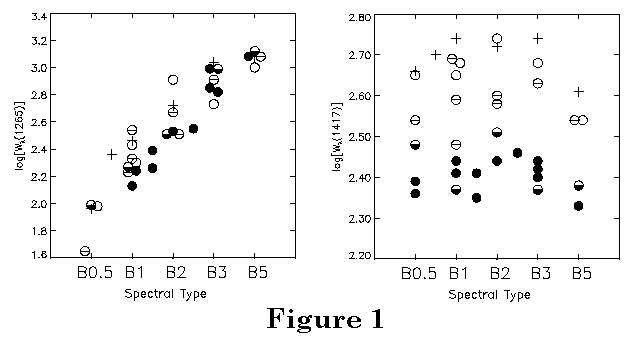
The following are examples of my research activities in the astronomy and astrophysics of OB star photospheres:

Figure 1: Sensitivity of UV Si II and III lines to temperature (right) and luminosity (left) in B stars. Symbols: filled = IV & V, half filled = III, belted circles = II, open circles = Ib & Iab, crosses = Ia (from Massa 1989).

Figure 2: Example of the progression of photospheric velocity gradients in luminous B star. The spectra are aligned on their relatively weak C II lines and it is evident that the strong Si III triplets become progressively asymmetric and blue shifted as the stellar luminosity increases (from Massa et al. 1992)
I have been interested in the physics of OB star winds for a number of years. Most recently, I have been collaborating with Prinja and Fullerton on several studies of wind variability in B supergiant winds. Some of my work in this field includes:
 Demonstration of the effects of
rotational in the late O star HD 93521 (Massa 1995). Because the
peculiarities in both the wind and photospheric lines of HD 93521 are
consistent with those expected from rapid rotation, this analysis probably
provides the best case for a gravitationally reddened star.
Demonstration of the effects of
rotational in the late O star HD 93521 (Massa 1995). Because the
peculiarities in both the wind and photospheric lines of HD 93521 are
consistent with those expected from rapid rotation, this analysis probably
provides the best case for a gravitationally reddened star.
 Demonstration that radial
velocity gradients are present in the photospheres of luminous B stars
(Massa et al. 1992). By taking advantage of the enormous strength of the
UV silicon lines in B stars and the wide range of line strengths, we
provided conclusive evidence for velocity gradients in the line forming
regions of luminous B stars.
Demonstration that radial
velocity gradients are present in the photospheres of luminous B stars
(Massa et al. 1992). By taking advantage of the enormous strength of the
UV silicon lines in B stars and the wide range of line strengths, we
provided conclusive evidence for velocity gradients in the line forming
regions of luminous B stars.
 The establishment of a silicon
based UV spectroscopic classification system for B stars (Massa 1989).
By confining the classification criteria to silicon liens, this approach
provides an excellent tie in to Walborn's optical system.
The establishment of a silicon
based UV spectroscopic classification system for B stars (Massa 1989).
By confining the classification criteria to silicon liens, this approach
provides an excellent tie in to Walborn's optical system.
 Determination of the intrinsic UV
continua of O stars (Massa et al. 1985, Massa & Conti 1981). By
concentrating on open clusters containing O stars and using the cluster
main sequence B stars to determine the extinction and test its
variability, this work remains the only consistent determination of the
UV continua of O stars.
Determination of the intrinsic UV
continua of O stars (Massa et al. 1985, Massa & Conti 1981). By
concentrating on open clusters containing O stars and using the cluster
main sequence B stars to determine the extinction and test its
variability, this work remains the only consistent determination of the
UV continua of O stars.
 Quantified the magnitude of the
error introduced to dereddened UV continuum incurred by applying a
``mean'' extinction curve (Massa 1987). This analysis established that
extremely large errors can be introduced by dereddening a
stellar continuum with a mean curve.
Quantified the magnitude of the
error introduced to dereddened UV continuum incurred by applying a
``mean'' extinction curve (Massa 1987). This analysis established that
extremely large errors can be introduced by dereddening a
stellar continuum with a mean curve.
Derck Massa,